Abstract
This study examines the effect of mining pollutants and wear products on the rheological and tribological properties of a lubricating grease working in the microclimate of the Polkowice-Sieroszowice mine belonging to the KGHM Polska Miedź Group (Polkowice, Poland). The material under investigation is a commercial lubricating grease thickened with complex lithium soap, based on mineral oil with a molybdenum disulfide (MoS2) addition. A sample of the grease was taken from one of the friction junctions of a self-propelled drilling jumbo operated in the mine. Comparative tests of the fresh grease and the spent grease were carried out. For the two greases, rheological tests, i.e., dynamic oscillation tests and tests in steady flow conditions, were carried out at a constant shear rate. The rheological tests were conducted using a rotational rheometer. Moreover, the tribological characteristics of the tested greases under different friction junction loads were carried out using a ball-on-disc tribometer. Besides friction resistance, the lubrication ability of the two greases was also evaluated through an analysis of the wear of the steel disks after the friction process. Contour and topographic maps of the wear traces of the discs together with their wear profiles were compared.
1. Introduction
The operation of machines in underground mines requires vast knowledge and experience. Machines, such as excavators, loaders and drilling rigs, must be highly resistant to the extremely harsh operating conditions, including heavy mechanical loads, a confined space, high air humidity, dust, high temperature and natural hazards (shocks, cave-ins, etc.), prevailing underground. Machines working in underground mines must also satisfy the relevant safety standards and environmental requirements. Since personnel safety is a priority, machines must be equipped with proper protection systems and meet the standards for harmful emissions. The operation of machines in underground mines also requires scrupulous and regular maintenance and lubrication. It is essential that the personnel are properly trained in operating and maintaining mining machines and are aware of the hazards connected with working in underground mines. Regular technical surveys and machines condition monitoring are key for maintaining machines in working order and ensuring their safe operation. The mining environment poses huge challenges to engineers regarding the intensive wear of machine parts and their proper lubrication. Heavy loads, dynamic forces and vibrations can cause considerable wear of key machine parts and a lack of advanced knowledge in the fields of tribology and lubrication engineering can additionally shorten the life of machine components, lead to their breakdowns and necessitate their frequent repairs.
Dust and other pollutants are commonly present in the mining environment. Dust can deposit on machine surfaces and lead to increased friction and wear of vital parts and their damage. Pollutants, such as chemicals and substances harmful to health, can also adversely affect the efficiency of machines and require special protective measures. Moisture and saline water are often present in the mining environment. They can lead to the chemical wear of materials and also to the failure of electrical equipment, and to other problems. Mining machines must be properly protected against moisture and water by protective coatings, seals and drainage systems. Table 1 presents the characteristics of the microclimate prevailing in the underground mines belonging to the KGHM Polska Miedź Group [1].

Table 1.
Characteristics of microclimate in underground mines belonging to the KGHM Polska Miedź Group [1].
As it appears from the above table, mining machines work in an extremely aggressive environment. Salt in mine wastewater has a damaging effect on friction junctions and lubricating grease. In some mining areas, high temperatures, reaching up to 40 °C, occur. Such conditions can contribute to the quicker wear of lubricants, adversely affect their lubricating properties, lower lubrication performance and cause lubricant leakage from unsealed friction junctions. Contamination and its effect on the performance of lubricants (lubricating grease or oil) have been the subject of numerous research studies which have shown that as contaminants appear in a lubricated friction junction, the tribological [2,3,4,5,6] and rheological properties of the lubricant change [7,8,9]. In the case of greases, the changes greatly depend on the kind of thickener and the way in which the friction junction is lubricated [5,7]. Besides studies on the functional properties of greases subjected to contamination, several numerical simulations aimed at evaluating the behavior of solid contaminants in greases working in friction junctions have been conducted [10].
The aim of the present study is to evaluate the effects of contamination on the rheological and tribological characteristics of a commercial lithium grease working in a microclimate prevailing in underground mines. Mining pollutants and wear products appearing in the grease are considered to be its contaminants. This paper presents the results of comparative tests of the fresh grease and the grease subjected to work in one of the friction junctions of a mining machine. Rheological tests, i.e., dynamic oscillation tests and tests in steady flow conditions, at a constant shear rate are carried out. Structural changes occurring during the flow of the grease subjected to contamination are assessed. Moreover, both greases are tribologically tested and their lubricating ability in different friction junction load conditions is evaluated.
2. Material under Investigation
The material under investigation is a grease of consistency grade NLGI 1.5. The thickener used to produce the grease was lithium soap (lithium 12-hydroxystearate) and the oil base was mineral oil. The grease contained a solid lubricant in the form of molybdenum disulfide (MoS2). The product brochure does not specify the mass fraction of MoS2 in the lubricant composition. The properties of the investigated lubricating grease, according to the manufacturer’s declaration, are presented in Table 2.

Table 2.
Specifications of investigated grease (acc. to manufacturer-supplied data).
According to the manufacturer-supplied data, the grease is a multifunctional lubricant for lubricating master, low-speed and heavily loaded friction junctions. Besides solid additives, it contains chemical additives ensuring its excellent high-temperature properties and resistance to chemical wear. According to the manufacturer, the grease guarantees the long-lasting protection of friction junctions against the action of water.
A sample of the material under investigation was taken from one of the friction junctions of a self-propelled drilling jumbo (Figure 1). This machine is used to drill blast holes in underground mine faces. Drilling jumbos are equipped with advanced hydraulic, drive and control systems enabling precise drilling. They often include an integrated drilling tower rotate and lift mechanism, whereby the angle and depth of drilling can be adjusted to specific mining needs. Self-propelled drilling jumbos are specially designed for the difficult operating conditions prevailing in the mining industry. They are equipped with systems protecting them against dust, moisture and other environmental factors typical of such places. Thanks to their mobility and ability to perform precise drillings, drilling jumbos are vitally important tools in the mining industry, enabling effective drilling, increasing output and reducing the time needed for carrying out mining tasks.
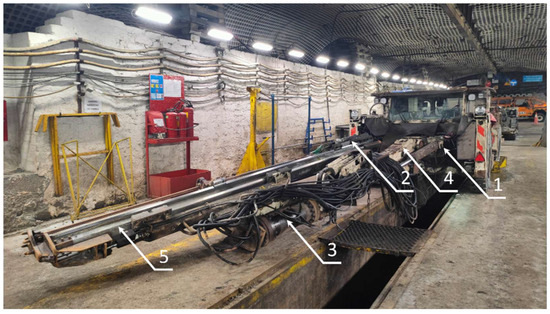
Figure 1.
Self-propelled drilling jumbo used in the Polkowice-Sieroszowice mine belonging to the KGHM Polska Miedź Group (Polkowice, Poland). Labels: 1—friction junction from which grease sample was taken for tests; 2—hydraulic drill; 3—rotation unit; 4—boom; 5—guiding frame.
A sample of the grease was taken (using the overflow method) from the sleeve-pin joint of the drill’s slewing actuator (Figure 2). The joint is an open unsealed friction junction which is particularly exposed to the action of the mine’s aggressive environment. The sleeve-pin joint enables drill slewing relative to the vehicle’s axis. This comes in useful when negotiating bends as the machine alone is over 10 m long. In the overflow method, the spent grease containing wear products was squeezed out of the friction junction by fresh grease by means of the machine’s central lubrication system pump. The material under investigation came directly from the lubrication gap. Prior to grease sample taking, any impurities were removed as far as possible from the friction junction’s structural elements. The grease sample was taken from the friction junction during maintenance works.
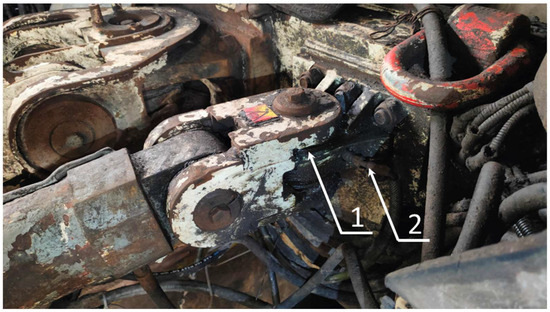
Figure 2.
Sleeve-pin joint. Labels: 1—lubricating gap from which grease sample was taken for tests; 2—central lubrication system conduit feeding grease to friction junction.
3. Test Methods
3.1. Raman Spectroscopy
The physicochemical tests were carried out using Raman spectroscopy. The micro-Raman apparatus (inVia™, Renishaw, Wotton-under-Edge, UK) was used to register the Raman spectra with an 830 nm excitation line. The measurements were conducted in the 2000–100 cm−1 region. The most representative spectra were analyzed. In the presented spectra, the 2000–3500 cm−1 region was excluded because no bands specific for the analyzed structure appear in it.
3.2. Rheological Tests
Rheological tests were carried out using a Physica Anton-Paar MCR 101 (Anton-Paar, Graz, Austria) rotational rheometer. The rheometer operated in the plate-plate mode at a constant measuring gap height of 1 mm. A sand-blasted plate (PP-40/S) with roughness = 2.8 μm and a 40 mm diameter was used to reduce slip at the wall. The rheometer included a Peltier heating-cooling module and an H-PTD200 insulating hood with air circulation inside the measuring head. During tests each grease sample was thermostated at a constant temperature of 40 °C with an accuracy of up to ±0.01 °C. Prior to each measurement, after the set temperature had stabilized, the sample was kept at a constant temperature in the rheometer’s head for a period of 5 min. This thermostating temperature value was chosen to reflect the characteristics of the microclimate prevailing in the mining areas in the Polkowice-Sieroszowice mine belonging to the KGHM Polska Miedź Group (Polkowice, Poland) (Table 1). Prior to each test, the samples were pre-sheared for 30 s at a constant shear rate amounting to 10 s−1 in order to ensure the same initial conditions. The rheological measurements were repeated five times and the results were presented as arithmetic means. For greater clarity, no confidence levels were marked on the diagrams. The software RHEOPLUS/32 was used to record the rheometric data.
In the first stage of the rheological investigations, dynamic oscillation tests were carried out. The storage modulus , the loss modulus ( and the damping coefficient of the greases as a function of their strain oscillating from 0.01 to 100% at constant oscillation frequency = 1 Hz were determined. The storage modulus is a measure of the stored elastic energy of a material, while the loss modulus is a measure of the dissipated viscous energy of a material. The damping coefficient is the ability or tendency to dissipate energy, expressed as a ratio of the loss modulus to the storage modulus. It is equal to the tangent of phase angle . Then, the critical strain was calculated using the iterative method. The critical strain value constituted the upper limit of the linear vicoelasticity (LVE) of the investigated grease. The strain amplitude for which the storage modulus amounted to 5% of its maximum values was assumed as the upper limit of LVE [11]. Then, an oscillation frequency sweep from 0.01 to 100 Hz in the linear elasticity range of the investigated grease was performed. Rheological dynamic oscillation tests are quite commonly used, i.a., to evaluate the mechanical stability of the microstructure of a thickener in new lubricating compositions or the effect of a change in grease production parameters on the durability of the microstructure. The results of such tests are available in, e.g., [12,13,14,15,16].
In the second stage of the rheological investigations, changes in shear stress as a function of grease shear time at a constant shear rate of 0.01 to 1 s−1 were recorded in order to evaluate the intensity of the changes taking place in the dispersion phase of the fresh grease and the grease subjected to contamination, especially at the beginning of their shear. It was also essential to determine the initial shear stress and the equilibrium shear stress in both samples. The authors initially intended to record shear stress–shear time curves at a greater shear rate, i.e., 10 and 100 s−1, but this was not done due to the very large fluctuations of shear stress in the spent grease sheared in such experimental conditions, which made an analysis of the test results simply impossible. Rheological parameters, including changes in shear stress, recorded during tests have a significant bearing on the behavior of greases in lubrication gaps between the working surfaces of a tribological junction, and also on their tendency to flow out of unsealed bearings and pin joints [17].
3.3. Friction Tests
Friction tests were carried out using a ball-on-disc tribometer T-11 (Institute for Sustainable Technologies–National Research Institute, Radom, Poland). The tribometer was equipped with a microprocessor control and measurement system consisting of a digital instrumentation amplifier Spider8, a BT-26 controller, sensors and measuring transducers and a computer set for the acquisition of measuring data. The sliding pair had the form of a stationary ball with a 6 mm diameter and hardness of 62 ± 2 HRC, made of steel 100Cr6, pressed against a rotating 6 mm thick disc 25.4 mm in diameter, made of carbon steel C45 (1.0503), with work surface roughness = 0.19 μm. The sliding pair worked in mixed friction conditions in the presence of the tested grease. Before each measurement, the friction junction’s elements were washed with benzine and dried. The tribological properties of the samples were evaluated by changing friction force between the ball and the disc at different contact loads and constant rotational speed of the disc. The tests were carried out at an average friction junction environment temperature of 22 °C, a pressure of 1021 hPa and an air humidity of 36%. Each measurement was performed for = 3600 s at contact load = 10, 30 and 50 N and linear velocity = 0.5 m/s. Thus, the friction path was 1810 m long. The kinetic friction coefficient was calculated for each of the sliding pairs.
3.4. Wear Tests
A Leica MAP DCM8 (Leica Microsystems, Wetzlar, Germany) optical profilometer operating in the confocal mode was used to investigate the wear of the steel discs. The profilometer was equipped with a 20× magnification lens with a vertical resolution of 2 nm. The data acquired from the scanning of a 600 × 800 μm work surface (fresh grease) and a 600 × 1500 μm work surface (worked grease) were processed using the Leica MAP DCM software. Finally, contour and topographic maps of the trace of wear left by the bearing ball on the steel discs and the wear profile (including its width, depth and surface area) were plotted. Each tribological test was repeated three times and the results were presented as arithmetic means. A standard deviation was the error measure.
4. Test Results and Discussion
Tests of greases in terms of changes in their physicochemical structure as a result of operation, based on a Raman spectroscopy analysis and the characterization of characteristic chemical moieties, were carried out. Regarding the organic moieties of the grease (the hydroxystearate part), bands characteristic of the methylene twist at 1300 cm−1 and the symmetric deformation mode (of the scissors type) of the methylene group and the C–H bending modes at approx. 1450 cm−1, as well as the vibrational frequency of the symmetric stretch of a carboxylate group at 1588 cm−1 can be observed in the fresh grease spectra (Figure 3). Comparing the spectra of the worked grease with those of the fresh grease, it is easily seen that the bands in the spectra for the worked grease have much lower intensity or have disappeared. The decrease in the intensity of the bands suggests the degradation of the interactions characteristic of a given wavelength, and so, for example, the disappearance of the carboxylate (C-COO) bending mode at 631 cm−1 and the stretching mode at 830 cm−1 indicates the degradation of the stearate structure [18]. The other characteristic bands at 781, 747 and 568 cm−1 also disappear as a result of working in the friction system. Further analysis is needed to explain the reasons for the observed structural changes. Factors such as complex conditions and mechanical loads, a local temperature increase and ubiquitous impurities affect the stability of lithium 12-hydroxystearate to a varying degree.
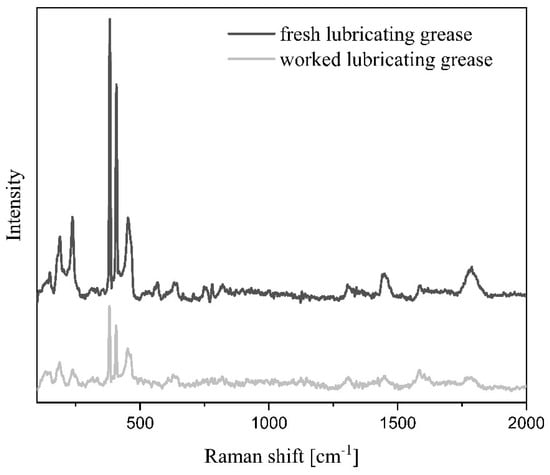
Figure 3.
Raman spectra of fresh and worked lubricating grease.
Further, S. Jimenez Sandoval et al. [19] indicated that the band at 383 cm−1, observed in the Raman spectra (Figure 3) of the worked grease, may come from crystalline 2H-MoS2 or from trigonal-prism-coordinated MoS2 which is more stable than a metastable phase of octahedrally coordinated Mo in MoS2. The 383 cm−1 band is inactive for the octahedrally coordinated MoS2 phase and such was the situation we observed in the case of the investigated fresh grease. This means that aging and perhaps also rising temperature during the lubricating process transform the metastable phase present in the investigated grease to a stable trigonal prismatic coordination phase [20]. This may happen because of the tendency of the single layers to restack and transform back to the more stable trigonal prism coordination of the bulk form of MoS2. Another place characteristic of the inorganic part of the grease (MoS2) in the obtained Raman spectra (Figure 3) is a set of 3 bands: 147 cm−1 (J1), 186 cm−1 (J2), 236 cm−1 (J3) for the fresh grease, and the first band much weaker and slightly shifted to 131 cm−1 and the other two at the same wavelengths for the worked grease. Such bands are characteristic of the superlattice in the base planes of the single MoS2 layers, whereas their absence is characteristic of the 2H-MoS2 structure. In our case, J1, J2 and J3 do not disappear in the spectra of the worked grease, but the intensity of the bands is much lower, which may indicate a certain amount of 2H-MoS2 in the tested material. This confirms the less stable structure of MoS2 in the fresh grease and its certain stabilization in the worked grease. It can also be assumed that the lack of complete disappearance of the J1, J2 and J3 bands results from the presence of a certain amount of water and impurities in the system, which, however, destabilize the investigated system. Contaminants, which are undoubtedly present in the tested samples, were not subjected to Raman spectroscopy measurements because special attention was focused on changing the structure of the lubricant itself. For this purpose, homogeneous samples were analyzed. Table 3 lists the characteristic vibrations discussed above with the corresponding chemical groups.

Table 3.
Proposed assignments of main Raman bands to fresh and worked grease in the 2000 cm−1 to 200 cm−1 range [18,19,20,21,22].
The rheological dynamic oscillation tests conducted at variable strain and a constant oscillation frequency showed significant differences in viscoelastic properties between the fresh grease sample and the worked grease sample. In the case of the fresh grease, the critical strain , being the limit of linear viscoelasticity, amounted to 0.144%. In the case of the worked grease, the strain was lower, amounting to 0.096% (Figure 4). One should also note that, in the case of the worked grease, much higher values of module and were recorded. The values of in the critical point were similar for the two greases. The results of the tests carried out by the authors are in contradistinction to the conclusions drawn in Osara et al. [23], where, on the basis of the law of thermodynamics, it was proved that modulus G’ decreases with grease degradation. However, in study [23], no impact of the contaminants coming from the environment in which a grease is working on the degradation of the structure of this grease was taken into account. Therefore, one can conclude that mining contaminants, including brine, coal dust and sulfur compounds, drastically change the viscoelastic properties of lubricating compositions working in the open friction junctions of mining machines. Analyzing the shear stress values for = 1, one can conclude that contaminants and wear products in grease significantly affect the value of yield stress , i.e., cause it to increase. The recorded value of for the fresh grease amounted to 412.10 Pa, while for the worked grease it was equal to 517.62 Pa. Figure 5 shows modules , and versus oscillation frequency in the range of linear viscoelasticity of the two greases, i.e., for . The strain value of 0.08% was assumed as safe.
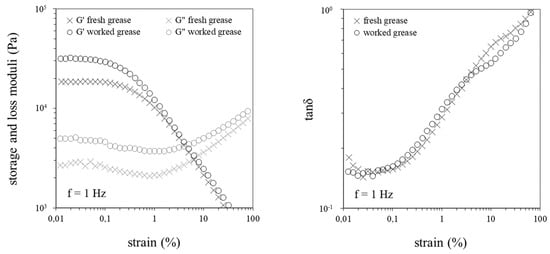
Figure 4.
Storage modulus , loss modulus and versus strain for the tested greases at oscillation frequency = 1 Hz.
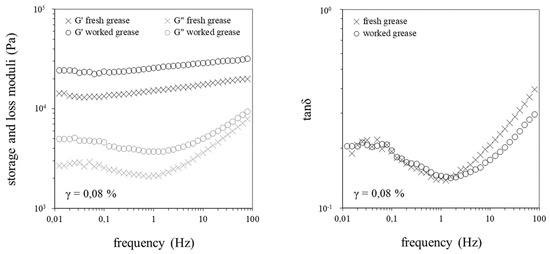
Figure 5.
Storage modulus , loss modulus and versus oscillation frequency for the tested greases in the range of their linear viscoelasticity.
Knowing the values of the amplitude of critical strain and storage modulus at the critical point for the fresh grease and the worked grease, the changes in their cohesion energy (J·m−3) were calculated. Cohesion energy density is used to quantitatively evaluate the degree and force of the flocculation of dispersed phase particles in a heterogenous system. It is a measure of the total sum of all the physicochemical interactions between the particles. This relationship is highly suitable for evaluating the forces of the interactions between thickener particles which exhibit anisometry, such as metal (including lithium) soaps [24,25]. Using it, one can evaluate the force of dipole–dipole interactions, van der Waals–London interactions, ionic interactions and hydrogen bonds. The higher the cohesion energy density, the more flocculated the microstructure [26]. Cohesion energy density is interrelated with stress in grease as follows [27]:
Substituting into Equation (1) one gets
The tests showed that the average values of for the fresh grease and the worked grease amounted to, respectively, 179.82 and 132.68 J·m−3. This means that the value of for the spent grease decreased by over 26% in comparison with that for the fresh grease. The decrease in the intensity of the characteristic bands in the Raman spectra (Figure 3) confirms the results presented above. The decrease or disappearance of characteristic bands directly affects the reduction in interactions between molecules in the tested lubricant system. Hence, one can conclude that contaminants and wear products in spent grease significantly affect interactions between lithium soap particles, weakening them substantially.
Also, the rheological tests carried out at a constant shear rate (in the range of 0.01 to 1 s−1) showed significant differences between the tested greases (Figure 6, Figure 7 and Figure 8). In the case of the worked grease, considerably higher values of shear stress were registered during the whole grease shearing cycle lasting 3600 s. Differences also became noticeable in the shape of the shear curves. The data acquired in the first 120 s of shearing supplied interesting information, namely, that as the shear rate increased, the characteristic shear stress () peak for the two greases decreased. Also, in this case one can notice differences in how changed after the maximum value had been reached.

Figure 6.
Shear stress versus shear time for the tested greases at shear rate = 0.01 s−1, registered during the hour-long test (a), and in the first 120 s of grease shearing (b).
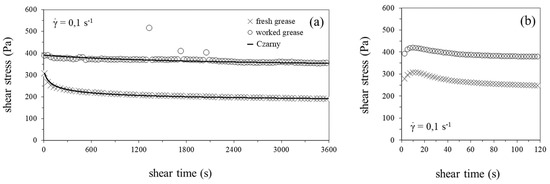
Figure 7.
Shear stress versus shear time for the tested greases at shear rate = 0.1 s−1, registered during the hour-long test (a), and in the first 120 s of grease shearing (b).

Figure 8.
Shear stress versus shear time for the tested greases at shear rate = 1 s−1, registered during the hour-long test (a), and in the first 120 s of grease shearing (b).
In order to assess the rate of changes taking place in the structure of the greases, the Czarny model [28] was used. The model enables one to determine shear stress at any grease shearing instant:
where —initial shear stress, —equilibrium shear stress,—time, —an exponent defining the path of the structure disintegration curve, and —a coefficient characterizing the intensity of structure disintegration, especially at the beginning of grease shearing.
A definite advantage of the model proposed by Czarny is that it can be used to determine the equilibrium shear stress characterizing the hypothetical total distintegration of a grease’s structure. This stress can be determined on the basis of the shear curve recorded in an arbitrary time interval at a constant value of [29].
The following conclusions can be drawn from the data collected in Table 4. The changes in the value of , particularly the ones registered in the initial phase of shearing for the spent grease, were milder than in the case of the fresh grease. This tendency is clearly apparent when one analyzes the values of the structure disintegration coefficient from the Czarny model.

Table 4.
Values of rheological parameters calculated from Formula (3) and their dependence on the shear rate .
For the spent grease, the coefficient ranged from 0.015 to 0.019 and it was lower than in the case of the fresh grease, which proves that in the adopted range of shear rate the structural changes taking place in the spent grease are milder. The effect of mining pollutants and wear products on the solidification of the grease is apparent here. This effect is also visible in the changes of parameter , being a ratio of initial stress and equilibrium stress .
Figure 9, Figure 10 and Figure 11 show the results of the tribological tests for the fresh grease and the worked grease for three friction junction loads = 10, 30 and 50 N registered over time = 3600 s. The tests were carried out using a ball-on-disc tribometer.
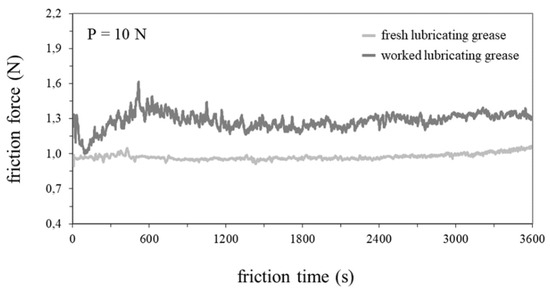
Figure 9.
Friction force over friction time for the tested greases under load = 10 N.
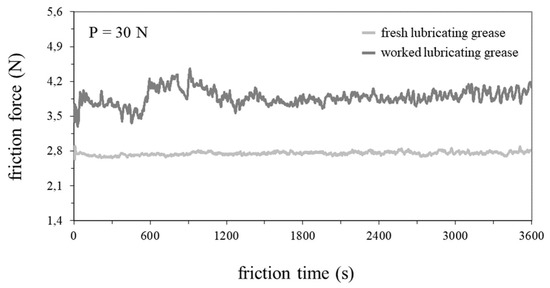
Figure 10.
Friction force over friction time for the tested greases under load = 30 N.
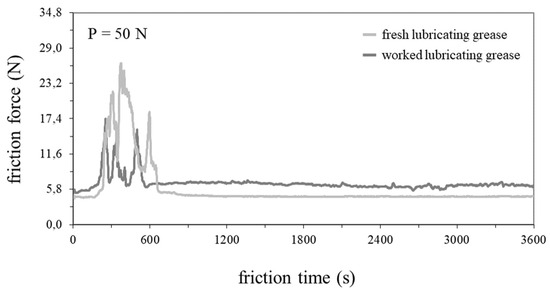
Figure 11.
Friction force over friction time for the tested greases under load = 50 N.
The test results indicate that contaminants in grease have a significant effect on frictional resistances. Regardless of the load value, the increase in the friction force in the tribological junction lubricated with the spent grease in comparison with an identical friction junction lubricated with the fresh grease amounted to over 20%. Moreover, the friction force values in the former case were characterized by high variability. This was undoubtedly due to the presence of contaminants and wear products in the grease. Table 4 contains averaged friction force values from the last 30 min of the test as in its initial phase running-in took place. The standard deviation (sd) was calculated at the confidence level of 0.95.
The highest value of the friction coefficient was registered for the friction junction lubricated with the worked grease under friction junction load = 50 N. This value amounted to 0.21230 and it was almost 28% higher than the friction force value registered for the friction junction working in similar conditions, lubricated with the fresh grease. The smallest differences between the tested greases were noted for load = 10 N.
The optical profilometer tests of the wear of the steel discs showed significant differences between the lubrication properties of the two greases. The wear profiles of the discs lubricated with the fresh grease were characterized by greater regularity, as is clearly evident in Figure 12 and Figure 13. As load of the friction junction increased, the profile surface areas ranged from 321.73 to 1393.13 µm2 (Table 5). In the case of the steel discs lubricated with the worked grease, the shape of the wear profiles was not so regular. This is undoubtedly the effect of the contaminants and wear products present in the grease. The surface areas of the wear profiles in this case ranged from 4365.42 to as much as 8135.65 µm2. Consequently, for the heaviest load, amounting to 50 N, the wear profile surface area increased nearly sixfold in comparison with the fresh grease. Moreover, the width of the wear profile which formed under different friction junction loads attracts attention. The highest values in this case, amounting to 1632.16 µm and 1546.91 µm, were recorded for the loads of 10 and 30 N, respectively. It is interesting to note that a somewhat smaller wear profile width, i.e., 679.64 µm, was recorded for the load of 50 N, which was nearly twice as high as in the case of the disc lubricated with the fresh grease. The recorded wear profile depth in this case amounted to as much as 25.289 µm and it was the highest depth value recorded in the whole experiment.
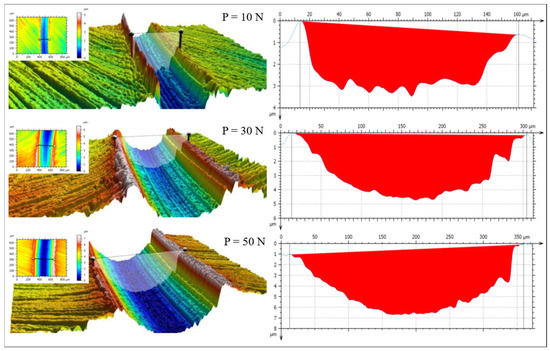
Figure 12.
Examples of the wear of steel discs after friction in the presence of fresh grease for loads = 10, 30 and 50 N.
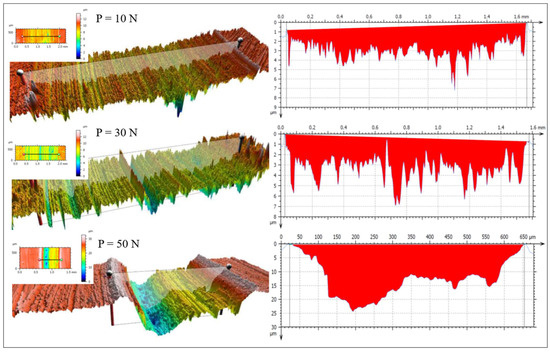
Figure 13.
Examples of the wear of steel discs after friction in the presence of worked grease for loads = 10, 30 and 50.

Table 5.
Results of tribological tests for the lubricated friction junction.
5. Conclusions
Rheological, tribological and spectroscopic tests of a fresh lithium grease and the grease which had worked in the microclimate of an underground mine showed significant differences between the greases. Several significant conclusions emerge from the tests carried out by the authors:
- (1)
- The mining contaminants contained in the spent grease contributed to a change in its viscoelastic properties. As a result, the critical strain value, being the limit of the grease’s linear viscoelasticity, decreased. Moreover, higher values of the storage modulus, the loss modulus and the flow limit were registered in the case of the worked grease.
- (2)
- A significant weakening of the interactions between lithium soap floccules in the grease subjected to contamination, manifesting itself in lower values of its cohesion energy, was noted. The spent grease’s cohesion energy was over 30% lower than that of the fresh grease.
- (3)
- Rheological tests carried out in steady shear rate conditions showed that the stress-shear time plots for the worked grease differed from those for the fresh grease. Changes in shear stress values, especially the ones registered in the initial phase of grease shearing, were much gentler than in the case of the fresh grease. The impact of mining contaminants on the solidification of the grease, manifesting itself in an increase in shear stress and dynamic viscosity registered during the flow of the grease, was clearly visible.
- (4)
- The rheological tests showed a significant contribution of the contaminants and wear products in the grease to an increase in frictional resistance and to a decrease in the grease’s lubricating ability. The friction force values registered during the tests were on average 20% higher than in the case of an analogous friction junction lubricated with the fresh grease. This applies to all the tribological junction load values adopted in the experiment.
- (5)
- Mining contaminants in the worked grease caused much greater wear of the steel disk in comparison with the tests carried out in the presence of the fresh grease. For the heaviest adopted load, i.e., 50 N, the increase in the disk wear profile surface area was almost sixfold. Also, the shape of the wear profile changed considerably.
- (6)
- Spectroscopic tests revealed significant differences between the Raman spectra of the fresh grease and those of the worked grease. The spectra of the spent grease were characterized by markedly lower intensity. Among other things, the degradation of lithium 12-hydroxystearate in the worked grease was noted. Also, the grease’s inorganic part, i.e., the MoS2 particles, underwent structural changes.
Author Contributions
The paper was created by M.P., P.A.S. and J.K.; M.P. proposed the research methodology, performed rheological tests, part of the tribological tests and developed the test results; P.A.S. performed part of the tribological tests, developed the test results and prepared samples for testing; J.K. performed spectroscopic tests and developed the test results. All authors have read and agreed to the published version of the manuscript.
Funding
This research was funded by the Department of Fundamentals of Machine Design and Mechatronic Systems and the Department of Mechanics, Materials and Biomedical Engineering at the Mechanical Engineering Faculty of the Wroclaw University of Science and Technology.
Acknowledgments
The authors would like to express their sincere thanks to KGHM Polska Miedź for consent to conduct the research.
Conflicts of Interest
The authors declare no conflict of interest.
References
- Wszelaczyński, G.; Capanidis, D.; Paszkowski, M.; Leśniewski, T. Operating Problems of Lubrication of Friction Nodes in Mining Machines Working in an Aggressive Environment. In International Scientific-Technical Conference on Hydraulic and Pneumatic Drives and Control; Springer International Publishing: Cham, Switzerland, 2020; pp. 228–238. [Google Scholar]
- Fitzsimmons, B.; Clevenger, H.D. Contaminated Lubricants and Tapered Roller Bearing Wear. ASLE Trans. 1977, 20, 97–107. [Google Scholar] [CrossRef]
- Odi-Owei, S.; Roylance, B. The effect of solid contamination on the wear and critical failure load in a sliding lubricated contact. Wear 1986, 112, 239–255. [Google Scholar] [CrossRef]
- Mizuhara, K.; Tomimoto, M.; Yamamoto, T. Effect of Particles on Lubricated Friction. Tribol. Trans. 2000, 43, 51–56. [Google Scholar] [CrossRef]
- Cyriac, F.; Lugt, P.M.; Bosman, R.; Venner, C.H. Impact of Water on EHL Film Thickness of Lubricating Greases in Rolling Point Contacts. Tribol. Lett. 2016, 61, 23. [Google Scholar] [CrossRef]
- Hudedagaddi, C.B.; Raghav, A.G.; Tortora, A.M.; Veeregowda, D.H. Water molecules influence the lubricity of greases and fuel. Wear 2017, 376–377, 831–835. [Google Scholar] [CrossRef]
- Cyriac, F.; Lugt, P.M.; Bosman, R. Impact of Water on the Rheology of Lubricating Greases. Tribol. Trans. 2016, 59, 679–689. [Google Scholar] [CrossRef]
- Cyriac, F.; Lugt, P.M.; Bosman, R. The Impact of Water on the Yield Stress and Startup Torque of Lubricating Greases. Tribol. Trans. 2017, 60, 824–831. [Google Scholar] [CrossRef][Green Version]
- Zhou, Y.; Bosman, R.; Lugt, P.M. On the Shear Stability of Dry and Water-Contaminated Calcium Sulfonate Complex Lubricating Greases. Tribol. Trans. 2019, 62, 626–634. [Google Scholar] [CrossRef]
- Westerberg, L.-G.; Farré-Lladós, J.; Sarkar, C.; Casals-Terré, J. Contaminant Particle Motion in Lubricating Grease Flow: A Computational Fluid Dynamics Approach. Lubricants 2018, 6, 10. [Google Scholar] [CrossRef]
- Shih, W.-H.; Shih, W.Y.; Kim, S.-I.; Liu, J.; Aksay, I.A. Scaling behavior of the elastic properties of colloidal gels. Phys. Rev. A 1990, 42, 4772–4779. [Google Scholar] [CrossRef]
- Ahme, L.; Kuhn, E.; Canto, M.D. Experimental Study on the Expended Energy on Structural Degradation of Lubricating Greases. Tribol. Lett. 2022, 70, 81. [Google Scholar] [CrossRef]
- Delgado, M.A.; Secouard, S.; Valencia, C.; Franco, J.M. On the steady-state flow and yielding behaviour of lubricating greases. Fluids 2019, 4, 6. [Google Scholar] [CrossRef]
- Yeong, S.; Luckham, P.; Tadros, T. Steady flow and viscoelastic properties of lubricating grease containing various thickener concentrations. J. Colloid Interface Sci. 2004, 274, 285–293. [Google Scholar] [CrossRef]
- Martín-Alfonso, J.E.; Moreno, G.; Valencia, C.; Sánchez, M.C.; Franco, J.M.; Gallegos, C. Influence of soap/polymer concentration ratio on the rheological properties of lithium lubricating greases modified with virgin LDPE. J. Ind. Eng. Chem. 2009, 5, 687–693. [Google Scholar] [CrossRef]
- Franco, J.; Delgado, M.; Valencia, C.; Sánchez, M.; Gallegos, C. Mixing rheometry for studying the manufacture of lubricating greases. Chem. Eng. Sci. 2005, 60, 2409–2418. [Google Scholar] [CrossRef]
- Lugt, P.M. Grease Lubrication in Rolling Bearings; John Wiley & Sons: Hoboken, NJ, USA, 2012. [Google Scholar]
- Sahoo, R.R.; Biswas, S.K. Effect of layered MoS2 nanoparticles on the frictional behavior and microstructure of lubricating greases. Tribol. Lett. 2014, 53, 157–171. [Google Scholar] [CrossRef]
- Jiménez Sandoval, S.; Yang, D.; Frindt, R.F.; Irwin, J.C. Raman study and lattice dynamics of single molecular layers of MoS2. Phys. Rev. B 1991, 44, 3955. [Google Scholar] [CrossRef] [PubMed]
- Yang, D.; Sandoval, S.J.; Divigalpitiya, W.M.R.; Irwin, J.C.; Frindt, R.F. Structure of single-molecular-layer MoS2. Phys. Rev. B 1991, 43, 12053. [Google Scholar] [CrossRef]
- Suhaimi, N.S.; Ishak, M.T.; Din, M.F.M.; Hashim, F.R.; Rahman, A.R.A. Raman Spectroscopy Characterization of Mineral Oil and Palm Oil with Added Multi-Walled Carbon Nanotube for Application in Oil-Filled Transformers. Energies 2022, 15, 1534. [Google Scholar] [CrossRef]
- Gorelik, V.S.; Bi, D.; Voinov, Y.P.; Vodchits, A.I.; Gorshunov, B.P.; Yurasov, N.I.; Yurasova, I.I. Raman Spectra of Lithium Compounds. In Journal of Physics: Conference Series; IOP Publishing: Bristol, UK, 2017; Volume 918, p. 012035. [Google Scholar]
- Osara, J.A.; Chatra, S.; Lugt, P.M. Grease material properties from first principles thermodynamics. Lubr. Sci. 2022, 1–15. [Google Scholar] [CrossRef]
- Paszkowski, M.; Olsztyńska-Janus, S.; Wilk, I. Studies of the kinetics of lithium grease microstructure regeneration by means of dynamic oscillatory rheological tests and FTIR–ATR spectroscopy. Tribol. Lett. 2014, 56, 107–117. [Google Scholar] [CrossRef]
- Paszkowski, M.; Szott, M. The influence of temperature on the rheological properties of fibrous lubricating compounds with selected aolid additives. Quarterly Tribologia 2019, 287, 71–76. [Google Scholar] [CrossRef]
- Tadros, F.T. Rheology of Dispersions: Principles and Applications; Wiley: Hoboken, NJ, USA, 2010. [Google Scholar]
- Tadros, F.T. Use of viscoelastic measurements in studying interactions in concentrated dispersions. Langumir 1990, 6, 28–35. [Google Scholar] [CrossRef]
- Czarny, R. Effect of Temperature on the Thixotropy Phenomenon in Lubricating Greases. In Proceedings of the Japan International Tribology Conference, Nagoya, Japan, 15–19 August 1990; pp. 1013–1018. [Google Scholar]
- Czarny, R. Badania Zjawisk Związanych z Przepływem Smarów Plastycznych w Układach Smarowniczych (Investigation of Phenomena Connected with the Flow of Lubricating Greases in Lubrication Systems); Wroclaw University of Science and Technology Publishing House: Wroclaw, Poland, 1992. [Google Scholar]
Disclaimer/Publisher’s Note: The statements, opinions and data contained in all publications are solely those of the individual author(s) and contributor(s) and not of MDPI and/or the editor(s). MDPI and/or the editor(s) disclaim responsibility for any injury to people or property resulting from any ideas, methods, instructions or products referred to in the content. |
© 2023 by the authors. Licensee MDPI, Basel, Switzerland. This article is an open access article distributed under the terms and conditions of the Creative Commons Attribution (CC BY) license (https://creativecommons.org/licenses/by/4.0/).